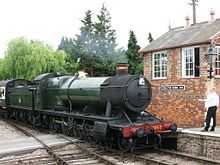Williton railway station
| Williton | |
|---|---|
 | |
| Location | |
| Place | Williton |
| Area | West Somerset |
| Coordinates | 51°10′00″N 3°18′33″W / 51.1667°N 3.3092°WCoordinates: 51°10′00″N 3°18′33″W / 51.1667°N 3.3092°W |
| Grid reference | ST085415 |
| Operations | |
| Original company | West Somerset Railway |
| Post-grouping | Great Western Railway |
| Operated by | West Somerset Railway |
| Platforms | 2 |
| History | |
| 1862 | Opened |
| 1971 | Closed |
| 1976 | Opened in preservation |
| Stations on heritage railways in the United Kingdom | |
| A B C D E F G H I J K L M N O P Q R S T U V W X Y Z | |
| UK Railways portal | |
Williton railway station is a station in Williton, Somerset, England. It was opened by the West Somerset Railway in 1862 and closed by British Rail early in 1971. It was reopened in 1976 by the present day West Somerset Railway, a heritage line. Locomotive workshops are situated here and it is the headquarters of the Diesel and Electric Preservation Group (DEPG).
History

The station was first opened on 31 March 1862 when the West Somerset Railway started operations between Norton Junction and Watchet. A single platform was provided, on the left side of trains travelling towards Watchet. In 1874 a second track and platform was opened and trains could then pass in the station; a new road bridge was built at the south end of the station before the loop was opened, but the level crossing next to the platform was left in place. The railway was operated by the Bristol and Exeter Railway which became a part of the Great Western Railway in 1876,[1] but the West Somerset Railway remained an independent company until 1922 when it too was absorbed by the Great Western. In 1907 and again in 1937 the passing loop was extended to allow longer trains to pass at Williton. In 1948, the line became a part of the Western Region of British Railways as a result of nationalisation in 1948. It was closed on 4 January 1971.[2]
On 28 August 1976 a new West Somerset Railway reopened the station. It was the terminus of the line from Minehead until 7 May 1978 when the line was extended to Stogumber. The goods shed and yard have since been adapted for restoring and repairing locomotives and carriages.[2]
Description
The main station building is on the northbound platform and is typical of a Bristol and Exeter Railway stations of the 1860s complete with an Italianate chimney. Next door is a small cafe and beyond that is the signal box which dates from 1875, the only Bristol and Exeter Railway one still in use. It operates the signals and overlooks the level crossing at the south end of the station. Beyond this is a small store which dates from 1862, and the road bridge. On the other side of the station building is the goods shed, now used as a diesel heritage visitor centre, and the locomotive workshops.[2]
The opposite platform was built in 1874, and has always been the site of a wooden waiting room.[2] A new footbridge was brought into use on 16 July 2011 so that people can cross to the second platform without having to cross the tracks on the level crossing. It had been in use at Trowbridge railway station.[3] Behind this platform is a box hedge garden which is over 100 years old.
The newspaper kiosk,[4] plate layers hut,[5] signal box,[6] waiting room and east platform[7] and booking office[8] are listed buildings.
Railway workshops

The station is a major site for the WSR's workshops. The former goods shed was converted for use by the DEPG as a locomotive workshop; this has since been supplemented by a purpose-built workshop nearby. At the far end of the station yard is a pre-fabricated building that is used for steam locomotive and coach overhauls by the West Somerset Railway Association, the volunteer supporters of the West Somerset Railway; it was originally erected at Swindon Works in 1899 and is Grade II listed[2] and was donated by Tarmac Ltd following the closure of the works.
Services
Trains run between Minehead and Bishops Lydeard at weekends and on some other days from March to October, daily during the late spring and summer, and on certain days during the winter.[9]
| Preceding station | Following station | |||
|---|---|---|---|---|
| Doniford Halt | West Somerset Railway | Stogumber | ||
References
- ↑ MacDermot, E T (1931). History of the Great Western Railway. 2 (1863-1921) (1 ed.). London: Great Western Railway.
- ↑ 2.0 2.1 2.2 2.3 2.4 Oakley, Mike (2006). Somerset Railway Stations. Bristol: Redcliffe Press. ISBN 1-904537-54-5.
- ↑ "Williton footbridge opened". West Somerset Railway Journal (West Somerset Railway Association) (135): 6. 2011.
- ↑ "Newspaper kiosk". Images of England. English Heritage. Retrieved 28 February 2010.
- ↑ "Plate Layers hut". Images of England. English Heritage. Retrieved 28 February 2010.
- ↑ "Signal Box". Images of England. English Heritage. Retrieved 28 February 2010.
- ↑ "Waiting room and east platform". Images of England. English Heritage. Retrieved 28 February 2010.
- ↑ "Williton Railway Station Booking Office". Images of England. English Heritage. Retrieved 28 February 2010.
- ↑ "Timetables". West Somerset Railway. 2014. Retrieved 6 July 2014.
External links
| Wikimedia Commons has media related to Williton railway station. |
- Diesel and Electric Preservation Group
- Williton Station website
- West Somerset Railway - Williton station page
| ||||||||||||||||||||||||||||||||||||||||||||